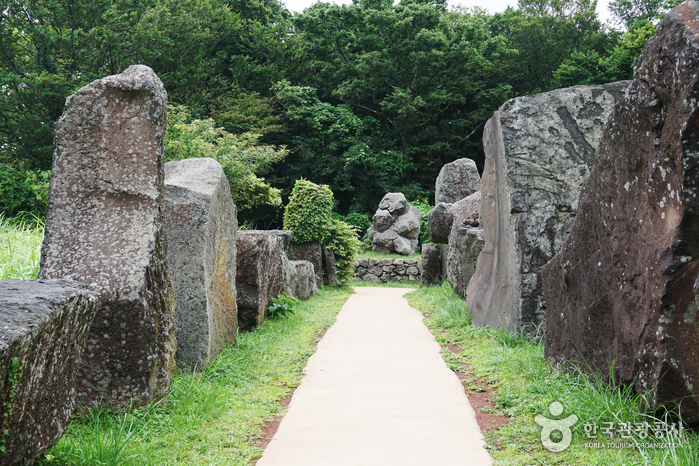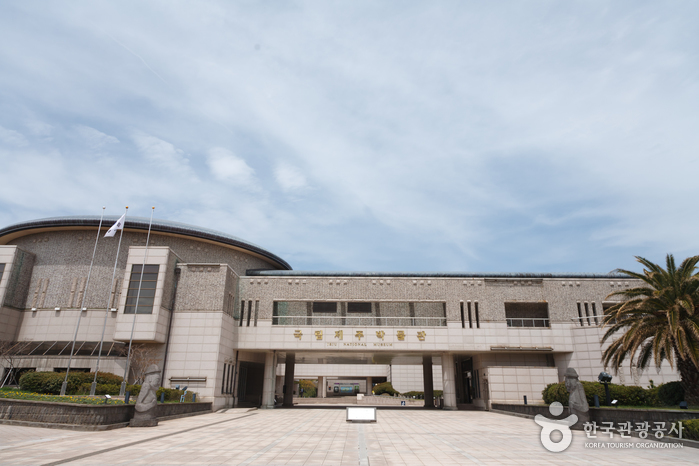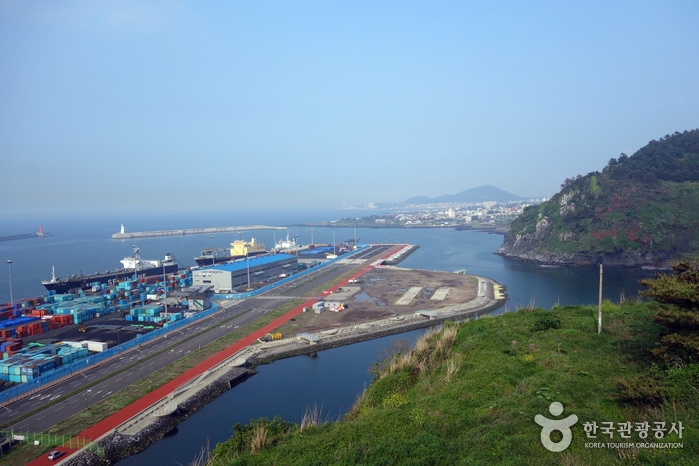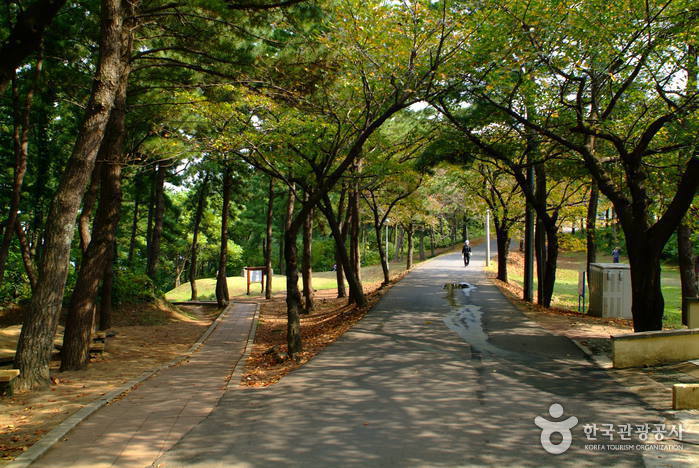Byeoldobong Peak (Beri Oreum) (별도봉(베리오름))
10.1 Km 7449 2020-02-24
Seonban-ro, Jeju-si, Jeju-do
+82-64-740-6000
Situated in the east of Hwabuk 1-dong and along the coast, Byeoldobong is a parasitic mountain made of siliciclastic sedimentary rocks and lava. Its northern slope is dominated by steep cliffs where a large rock called Jasalbawi Rock (Suicide Rock) is located. At the bottom of the cliffs are Goraegul Cave (Whale Cave) and an oddly-shaped rock that looks like a mother carrying her child on her back.
Despite being only 136m high, Byeoldobong is home to Jangsu Trail, a walking path that stretches over 1.8km around coastal cliffs, overlooking the ocean. Considered the most pleasant trail on Jeju Island, it offers a spectacular view of numerous peaks, Jeju Port and its nearby villages, and the emerald-blue sea. Naturally, it is a popular tourist destination for family visitors and couples.
Jeju Stone Park (제주돌문화공원)
10.3 Km 51155 2024-01-11
2023 Namjo-ro, Jocheon-eup, Jeju-si, Jeju-do
Located in Jocheon-eup, Jeju-si, Jeju Stone Park was inspired by Jeju's culture and applications of stones. The main theme focuses on the foundation and identity of Jeju Island, based on the myth of Seolmundae Halmang (Grandmother Seolmundae), who created Jeju Island and the stones of Obaek Janggun (Five Hundred Generals). The park serves as a historical and cultural space where collected stones respresent Jeju's foundation and culture.
Yongcheondonggul Cave [UNESCO World Natural Heritage Site] (용천동굴 [유네스코 세계자연유산])
10.4 Km 24114 2020-11-27
Woljeong-ri, Jeju-si, Jeju-do
+82-1600-0064
Yongcheondonggul Cave is the most typical form of lava tunnel on Jeju Island and with a total length of approximately 2,470 meters, it is one of the largest. It has a unique topology and rich limestone formations such as lava terrace, lava shelves, lava waterfalls, and 140 meters of lava rolls. In particular, a range of carbonate formations such as straw soda, stalactite, columns, flowstones, cave corals, and aragonite crystals can be found inside this large cave that also contains a lake. This unique cave is astounding in terms of its geological value and beauty. There are also items that can be found throughout the cave that appear to have been brought in by people who lived on the island long ago, such as pieces of pottery, animal bones, ironware, charcoal and other substances.
* The UNESCO World Heritage inscribed Geomunoreum Lava Tube System consists of Bengdwigul, Manjanggul, Gimnyeonggul, Yongcheondonggul and Dangcheomuldonggul Caves.
Jeju National Museum (국립제주박물관)
10.6 Km 27439 2021-08-06
17, Iljudong-ro, Jeju-si, Jeju-do
+82-64-720-8000
Opened on June 15, 2001, Jeju National Museum is a history museum that displays, preserves and studies Jeju Island’s historical and cultural assets. Jeju National Museum houses various remains excavated from ruins, including meaningful relics from the prehistoric age through to the Joseon dynasty. It boasts unique traditional culture and holds special exhibitions each year.
Sanji Lighthouse (산지 등대)
10.6 Km 35329 2021-03-18
108-1, Sarabongdong-gil, Jeju-si, Jeju-do
+82-64-740-6000
The name Sanji derives from the area being recorded as Sanjichon Village, literally translated as the mountainous village, in Tamna Sullyeokdo, a book of paintings showing life in Jeju. This record was created in 1702 by painter Kim Nam-gil, under the command of the Jeju Province governor, Lee Hyeong-sang.
Sanjicheon Stream originates from Hallasan Mountain and empties itself into the sea. Sitting halfway up Sarabong Peak, one of the signature parks on Jeju-do island, Sanji Lighthouse overlooks the port of Jeju.
Jeju Myeongdoam Youth Hostel (제주 명도암유스호스텔)
10.7 Km 15365 2020-03-17
393, Myeongnim-ro, Jeju-si, Jeju-do
+82-64-759-9596
Jeju Myeongdoam Youth Hostel is located near the trail chosen as one of the top 10 most beautiful trail as well as many attractions. Its central location offers traveling convenient for its guests and rooms are arranged in family to dormitory styles to accomodate varying group sizes. Nearby destinations include Jungmun Resort, Jeju City Hall and Cheonjiyeon Falls.
Sarabong Park (사라봉공원)
10.7 Km 19959 2020-03-19
74, Sarabongdong-gil, Jeju-si, Jeju-do
+82-64-728-4643
Sarabong Park is located on a 143 meter-high hill just east of Dongmun Rotary in Jeju. The park is best known for its spectacular sunset views, which is often regarded as a perfect complement to Seongsan Ilchulbong Peak's view of the sunrise.
Sarabong Park offers a spectacular view of the expansive blue waters to the north and Hallasan Mountain to the south, making it popular among locals and tourists alike. Visitors traveling by bus will see Mochungsa Temple on the way to the park. Byeoldobong Peak lying to the east features a paragliding runway. At the foot of Sarabong is Udang Library. The road from the library, passing behind Sarabong Peak to Jeju Harbor and to Tapdong provides a very scenic driving route.
Sarabong Peak (사라봉)
10.7 Km 19826 2021-05-24
61, Sarabongdong-gil, Jeju-si, Jeju-do
+82-64-728-3602
Situated to the east of Jejuhang Port, Sarabong Peak is the main oreum (volcanic cone) that separates the city from the sea. The peak offers views of the ocean to the north and magnificent Hallasan Mountain to the south. It is recommended to reach the top in the late afternoon to catch the reddish glow of the sunset glittering off the ocean.
Geomunoreum Lava Tube [UNESCO World Natural Heritage Site] (거문오름 [유네스코 세계자연유산])
10.8 Km 54870 2024-03-13
Seonheul-ri, Jocheon-eup, and Deokcheon-ri, Gujwa-eup areas in Jeju
+82-64-710-8981
Geomunoreum Lava Tube stands out as one of the distinct oreum (the Jeju language term for parasitic cones) on Jeju Island, marked by its extensive network of around 20 lava tubes running through the volcanic structure. This site is not only a geological marvel but also a sanctuary for diverse biological species. Visitors begin their journey at the Jeju World Natural Heritage Center, from where a path leads directly to the Geomunoreum Lava Tube. It is important to note that prior reservations are required to visit. The significance of this location as a key geological feature was recognized when it was designated as a UNESCO World Natural Heritage Site in 2007. Additionally, an international trekking event is hosted annually to celebrate its global importance.
Jeju World Natural Heritage Center (제주 세계자연유산센터)
10.8 Km 25386 2021-05-31
569-36, Seongyo-ro, Jeju-si, Jeju-do
+82-1800-2002
The Jeju World Natural Heritage Center was established to acknowledge Jeju Island’s value as the sole UNESCO World Natural Heritage in Korea. It is comprised of various facilities including a 4D video room, lava tunnel experience, origins of Jeju-do, and many other activities that visitors can experience first-hand. Jeju World Natural Heritage Center is located in the Geomunoreum Lava Tube System, which was designated as a UNESCO World Natural Heritage in 2007, one of the 20 ecological tourism spots selected by the Ministry of Environment of Korea in 2009, as well as a Korean-style ecological tourism model.
* Opening date: September 4, 2012





![Geomunoreum Lava Tube [UNESCO World Natural Heritage Site] (거문오름 [유네스코 세계자연유산])](http://tong.visitkorea.or.kr/cms/resource/62/2661662_image2_1.jpg)
 English
English
 한국어
한국어 日本語
日本語 中文(简体)
中文(简体) Deutsch
Deutsch Français
Français Español
Español Русский
Русский